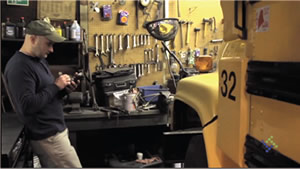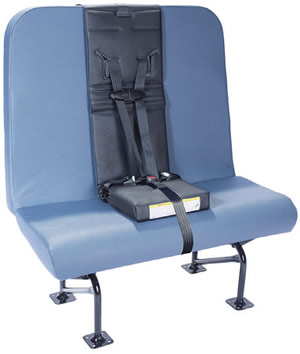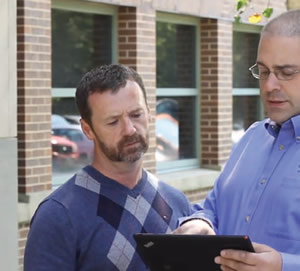Transportation's Key Words: Safety, Efficiency and Service

PHOTO COURTESY OF TYLER TECHNOLOGIES
Have you seen these transportation-related numbers from the U.S. Department of Transportation’s National Highway Traffic Safety Administration (NHTSA)?
- “Since 2003, there have been 1,353 people killed in school-transportation-related crashes — an average of 135 fatalities per year.” NHTSA’s publication, “School-Transportation-Related Crashes” (Revised June 2014) (www-nrd.nhtsa.dot.gov/Pubs/811890.pdf ), notes additional facts concerning these fatalities.
- “Since 2003, 119 school-age pedestrians (younger than 19) have died in school transportation-related crashes. Sixty-five percent were struck by school buses…. There were 42 (35 percent) school-age pedestrians 5 to 7 years old killed in school transportation-related crashes and a similar number and percentage who were 8 to 13 years old.”
- “From 2003 to 2012, 174 school-age children died in school-transportation related crashes. Fifty-five were occupants of school transportation vehicles and 119 were pedestrians.”
- “From 2003 to 2012, among the 106 occupants killed in school transportation vehicles, 46 were drivers and 60 were passengers.” Changing gears a bit, did you know that school bus seating has undergone tremendous safety innovation in recent years? “The interesting thing about school bus seating is that the design is intended to protect children, the most valuable resource we have,” says Tony Everett, chief operating officer of Hickory, N.C.-based HSM. “Safety has dramatically improved during the last 25 years and continues to improve on a regular basis.”
Specifically, Everett cites changes in NHTSA standards in 2009, the first in almost 20 years. “From there,” he says, “the industry has continued to improve the safety of our children through the use of energy-absorbing materials, compartmentalization and securement devices.” He also notes that the performance and technology that goes into seatbelt design is continuing to improve. These innovations mean that administrators can count on products to perform in the manner they were designed.

PHOTO COURTESY OF HSM SOLUTIONS
Administrators must also contribute to product performance, Everett continues. They must periodically inspect the equipment and replace worn or damaged parts. For example, if a seat cushion is cut, exposing the foam inside, then the fire blocking on the cushion isn’t able to protect the foam from burning in the event of a fire. Similarly, a frayed seat belt is at risk of not performing in the event of an accident. And if a seat is removed and not properly reinstalled, there’s a risk that it won’t absorb energy in the event of an accident.
There’s no doubt that school bus safety is an enormous concern for everyone from parents to school administrators to law enforcement officials to government officials. But so is efficiency, especially from school administrators’ point of view. Efficient operations equals improved safety. Improved safety equals efficient operations. In summary, this equals savings gleaned through reduced gas consumption, reduced repairs, fewer buses and fewer drivers.
Here’s a specific example. “It can cost a school district $50,000 to $70,000 per year to run one school bus,” says Ted Thien, senior vice president and general manager in the Latham, N.Y. office of Versatrans, a school transportation software suite offered by Tyler Technologies. “If software can — and it can — help administrators get the same number of students to school on time via more efficient routes using fewer buses, then the 10 to 15 percent savings that are realized by reducing the number of vehicles they’re using to provide the same level of service can be redirected to the classroom.”
With safety and efficiency in mind, here’s how two districts have recently made changes that greatly improve both.
Pekin City Schools, Illinois
The City of Pekin, Ill., operates transportation for Pekin Public Schools District 108 and Pekin Community High School District 303. When Ty Whitford, superintendent of Transportation, started about five years ago, the school bus fleet averaged 10 years old and equipment was in dire need of improvement. With 100 buses and 4,000 students transported daily, he knew there was room for improvement.
Whitford came up with a plan and presented it to the administration. “Once everyone saw the direction and mindset we wanted to take in improving transportation and how important transportation is, they got on board and involved in helping us move from being in the busing dark ages to the busing age of enlightenment,” he says.
First, Whitford began changing out the fleet, which reduced maintenance costs, improved safety in offering buses with new safety features, and saved money via better gas mileage.

PHOTO COURTESY OF TYLER TECHNOLOGIES
Getting directions. A Tyler Technologies employee demonstrates the use of route planning on a mobile device. Through the use of software, administrators are getting the same number of students to school on time via more efficient routes using fewer buses. The savings are being redirected to the classroom.
Then, Whitford began improving efficiency and safety through technology. Specifically, the city invested about $100,000 in technology that includes routing software, cameras, and GPS. The routing software allows administrators to plan efficient routes that reduce mileage and stops. Two cameras on each bus cover the entirety of the bus, “to eliminate he said/she said,” he says. And the GPS allows administrators to see historic data such as a bus’ path and speed, if the driver uses stop arms properly and if the driver stops at railroad intersections.
“The upgrade paid for itself in less than three years,” Whitford indicates. “One of the areas where we’ve saved money is in tracking engine idling.” But the upgrade has also helped with his greatest challenge: tracking students. “Sometimes there’s a disconnect and we want tell without a doubt that a student got on the bus. The student tracking software allows us to know for sure where students are.”
Overall, Whitford encourages administrators to adapt to change. “I’m an old-school guy,” he observes. “But if I’m willing to adapt to change, there are systems out there to help me move transportation forward and avoid the risk of becoming less efficient and less safe.”
Dubuque Community School District, Iowa
This past winter, a bus driver for Iowa’s Dubuque Community School District (DCSD) hit a sheet of ice on a remote road when it was dark, cold and snowing. She was helpless to control the bus, which carried four students, as it went off the road, but did not roll over. Because the bus was equipped with cameras and software, administrators simply pulled an SD card so that they and law enforcement officials could watch a video of what took place internally. Later, law enforcement praised the bus driver for keeping the students safe, in their seats and calm until help arrived.
“We’re always looking for ways to improve safety and efficiency, and that includes software,” observes Kris Hall, DCSD’s Transportation manager. “We believe software has increased safety because it has allowed us to improve communication, which is our greatest challenge, and, if we improve communication, we have a better, safer ride. Communication is key in a service-oriented environment, and that’s what my department is.
“Our software allows us to access driver location, bus location, student information, and driver and attendant information as fast as we can point-and-click,” Hall continues. “Because of this, we average one million safe miles per year, transporting 3,500 students in 82 school buses and one van, running more than 250 routes per day.” The district also runs more than 1,600 field and activity trips per year.
Hall has also worked to improve efficiency by putting policies, procedures and operations in writing that were ingrained in the previous manager’s memory. “We’re also improving the way we communicate with our staff in that we are using email, message boards, staff meetings and staff development (such as crisis prevention training) as opposed to just verbal communication,” he notes.
“What I hear fleet administrators say is they’re always to improve safety, service and efficiency,” says Thien. “Maintenance and routing software allows them to explore different scenarios to optimize the balance of those three elements.” Yet he’s shocked that about 70 percent of his new customers in any given year have never used routing software and only 30 to 50 percent of school buses are equipped with GPS. For administrators who have concerns, he advises that software is more user friendly than ever and the up front costs provide a real return on investment.
Safety
Telling Your Parents About School Bus Safety
Despite having school bus transportation provided to their students, many parents drop-off and pick-up their students on a daily basis, for a variety of reasons, which may include a misperception that auto transportation is safer than bus transportation. This creates its own set of challenges, including getting lines of cars off the street quickly so as to not back up traffic, keeping cars and pedestrians separate, and keeping drop-off and parking areas separate.
If your district wants to educate parents about school bus safety and encourage them to take advantage of the transportation the district provides, there is help through SchoolBusFacts.com, a project sponsored by the American School Bus Council (ASBC) and the National Highway Traffic Safety Administration (NHTSA). The project advocates on behalf of the quintessential American icon: the yellow school bus, providing a variety of marketing materials, including materials that administrators can distribute to parents.
This article originally appeared in the issue of .